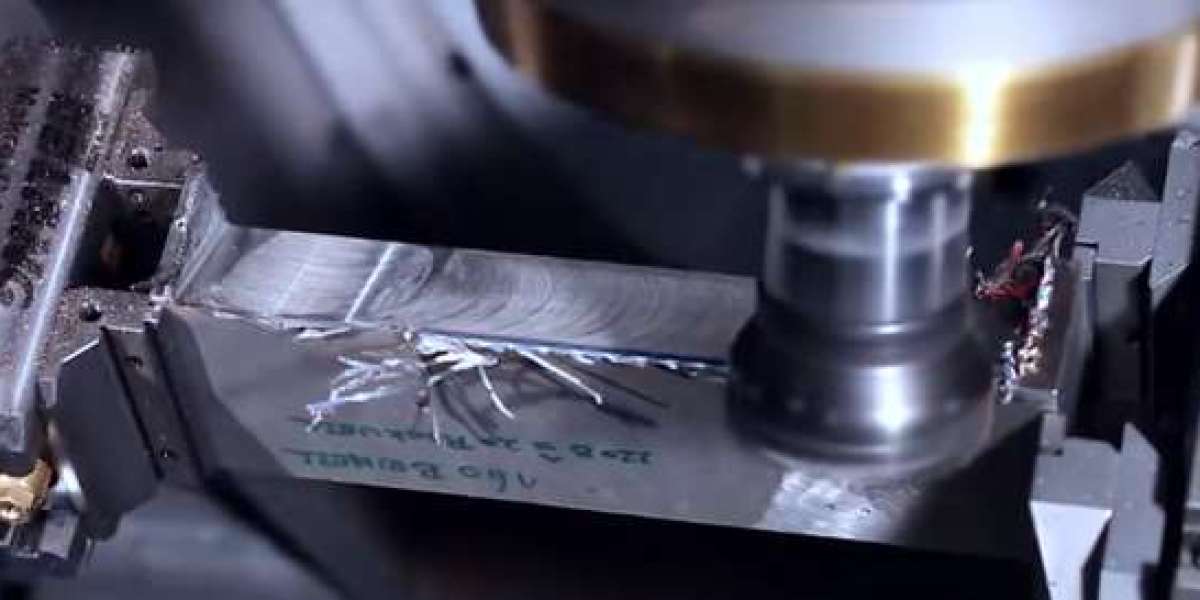Nickel-based superalloys have wide applications in aerospace, energy, and petrochemical industries for producing impeller components. As a typical difficult cutting material, they have high strength, oxidation resistance, and heat stability. During the cutting process, cutting tools suffer from severe thermal and mechanical load, leading to rapid tool wear, which significantly restricts machining efficiency and surface quality.

1. Introduction
Nickel-based superalloys, with their excellent high-temperature mechanical properties, improved corrosion resistance, and good microstructural stability, have become the preferred material for the manufacture of key impeller components in severe working conditions such as aero-engines, gas turbines, and nuclear equipment. The materials, however, have a special characteristic of high strength, low thermal conductivity, and severe work hardening, which makes them extremely difficult to machine by cutting. Especially in five-axis machining of complex impeller geometries, the superposition of challenging conditions such as long tool overhang, local high-temperature concentration, and asymmetric loads subjects tools to rapid wear or even sudden failure, decidedly affecting machining quality and production cycles. Therefore, the systematic study of types of tool wear, affecting factors, and evolution laws when machining nickel-based alloy impellers has significant theoretical value and engineering importance for the creation of efficient process measures and optimization of the tool.
2. Analysis of Cutting Characteristics of Nickel-Based Alloys
The high strength of nickel-based alloys is attributed to their strengthened microstructures, such as γ′ phases, carbides, and solid solution elements, which possess good tensile strength and hardness at high temperature, and therefore quickly increase cutting resistance. Low thermal conductivity causes most cutting heat to accumulate in the cutting zone, and the local temperature at the tool edge to rapidly rise above 800°C, which accelerates thermal wear and coating spalling. Additionally, nickel alloys have a strong tendency to work harden, and the hardness of the surface being machined is significantly greater after cutting. The next cut in continuous cutting will be subjected to materials of higher hardness, increasing tool loads drastically and encouraging composite wear on the rake face and edge area. These characteristics together constitute a very unfavorable machining condition for tools, necessitating systematic optimization efforts in tool design, process parameter selection, and cooling/lubrication conditions.
3. Tool Wear Types and Formation Mechanisms
In nickel-based alloy impeller machining, the tool wear rate and life are influenced by the synergistic effect of various factors like cutting parameters, tool materials and structural forms, cooling/lubrication conditions, etc. These effects form complex thermo-mechanical-chemical coupling effects under different working conditions, having significant impacts on tool surface damage morphology, wear mechanism, and even final life cycle. Therefore, comprehensive understanding of the action mechanisms of the above influencing factors is imperative in order to establish reasonable machining strategies and improve tool economy.
4.1 Cutting Parameters
Cutting speed, feed rate, and cutting depth are basic process parameters that affect tool wear. Though higher cutting speed can improve machining efficiency, it also significantly increases the temperature of the cutting zone, leading to thermal softening, oxidation, or even spalling of the tool coating. Increase in feed rate leads to higher single-edge cutting load, thereby improving mechanical impact and leading to micro-crack propagation at the edge, which is most vulnerable to edge chipping in the roughing operation. The deeper the cutting depth, the larger the normal force and cutting heat withstood, further enhancing thermo-mechanical wear on the rake and flank faces. Five-axis linkage impeller machining, especially for machining variable curvature flow channels and root thick areas, should adopt a steady-state strategy of medium-low speed, low feed, and multi-pass layered cutting to balance tool life and forming accuracy.
4.2 Tool Material and Geometry
Tool substrate and coating materials hold the secret to wear resistance. The commonly used fine-grain cemented carbides have good high-temperature strength and compressive capacity, which can be used for machining hard materials. In terms of coatings, multi-layer nano-coatings such as TiAlN and AlTiN have better thermal stability and oxidation resistance, which can minimize the friction coefficient as well as inhibit adhesive wear. From the perspective of geometric shape, the tool nose radius and moderate helix angle design can effectively reduce cutting force concentration and heat generation, improve cutting stability. In addition, edge honing and micro-edging are also very important techniques to delay edge breakage and improve the resistance of tool chipping, which is especially suitable for high-speed machining of nickel-based alloys with severe deformation resistance.
4.3 Cooling and Lubrication Conditions
Proper cooling can significantly decrease the tool thermal wear process. In machining nickel-based alloys impeller, internal cooling channels combined with high-pressure cooling (HPC) technology can directly act on the cutting zone, effectively removing heat, reducing the formation of thermal fatigue cracks, and facilitating chip removal. Minimum quantity lubrication (MQL) realizes lubrication and component cooling performance by an extremely small amount of oil mist, which can be applied to finishing conditions with environmental friendliness and low pollution advantages. In heavy load rough cutting, however, MQL cooling performance is not sufficient and must be blended with traditional emulsion or HPC systems. For complex contours and different posture cutting conditions, the nozzle direction, flow rate, and pressure should be reasonably arranged so that the coolant or lubricant can uniformly wet the tool cutting edge and rake face to decrease thermal shock and adhesion tendency.
4.4 Tool Path and Machine Stability
Besides the tool and process itself, machining path planning and machine tool system dynamic stiffness also directly affect tool wear. In five-axis linkage, the unreasonable path transition or posture switching will result in instantaneous load mutation, which will increase the micro-crack generation and expansion at the edge. Besides, micro-vibrations may be caused by low-rigidity fixture systems and spindle elements, which cause the tool to jump during cutting, encourage local thermo-mechanical (shock), and form stress concentration areas. The use of optimized tool path trajectories and contour machining strategies, as well as high-rigidity and high-damping process systems, is the key to suppressing abnormal wear.
4. Analysis of Influencing Factors on Tool Wear
Machining tool wear behavior is one of the primary effects on impeller finished product quality and machining efficiency, and its evolving mechanism is driven by many factors such as machining parameters, tool structure and material, and cooling/lubrication conditions. PREDICTABLE control of tool life and advanced process optimization become possible by controlling the action laws of each influencing factor.
4.1 Influence of Machining Parameters on Wear
Cutting parameters have direct effects on the thermo-mechanical coupling load of the tool and impose tremendous effects on wear forms (e.g., abrasive wear, diffusion wear, edge chipping, etc.). The typical parameters and their influence mechanisms are tabulated in the following table:
Parameter Type
Typical Value Range
Main Influence Mechanism
Cutting Speed Vc
25–80 m/min
High-speed cutting causes severe temperature rise in the cutting zone, leading to enhanced thermal fatigue and aggravated tool coating degradation
Feed per Tooth fz
0.03–0.12 mm/tooth
Larger feed is prone to induce periodic impact loads, causing micro-chipping and unstable wear of the cutting edge
Cutting Depth ap
0.2–1.5 mm
Deep cutting makes the tool bear greater cutting force and thermal load, increasing the risk of thermal cracks and mechanical fatigue
In practical process design, the parameter combination should be optimized to restrict the machining load in the tolerance range of the tool, balancing the efficiency and life relationship.
4.2 Tool Material and Geometric Structure
Tool materials are the basic assurance for resisting high-temperature wear and mechanical shock. The design characteristics of commonly used wear-resistant tools are as follows:
- Materials: High-hardness fine-grain cemented carbides (e.g., ultra-fine grain WC-Co substrates) possess excellent structural strength. When combined with nano-composite coatings like TiAlN, AlCrN, and nACo, they can effectively enhance the hot hardness and anti-fusion welding ability of the tool.
- Geometric Structure: Ball-end mills have good contour accuracy for impeller free-form surface machining. Micro-honing at the edge (e.g., 3–5 μm fillet) and chamfering can effectively delay the initial edge chipping and delay crack propagation.
- Structural Optimization: Adopting large chip flutes and variable helix angle structures not only facilitates chip evacuation but also slows down heat accumulation and improves cutting stability.
Moderately selecting tool materials and geometrical parameters can successfully reduce wear rates in both roughing and finishing operations.
4.3 Cooling and Lubrication Strategies
The temperature of the cutting zone is one of the main causes of aggravated tool wear, and reasonable cooling and lubrication measures are one of the key methods to control thermal load and improve wear condition:
- High-Pressure Cooling System (HPC): In the machining of titanium alloys and superalloys, high-pressure coolant can be directly sprayed onto the tool contact area to quickly remove heat and prevent coating spalling and diffusion wear.
- Internal Cooling Tool Channels: Tools integrated with internal coolant circulation systems are particularly effective in deep cavity machining, significantly reducing heat concentration at the tool root.
- Minimum Quantity Lubrication (MQL): Suitable for finishing processes under light load and clean environments, it can reduce cutting fluid pollution and extend the sharpness retention time of tools.
- Composite Additive Cutting Fluids: Cutting fluids added with antioxidants, extreme pressure agents, or nano-particles can form effective lubricating films in high-temperature areas, enhancing coating protection and reducing interfacial adhesion.
Combined application of various cooling and lubrication techniques, especially alteration of cooling methods in roughing and finishing switching, is effective in tool service life extension and machining reliability improvement.
5. Tool Life Evolution and Wear Prediction Model
The tools typically experience three stages of wear when machining nickel-based alloy impellers: the initial wear period (first 5–10 minutes) with stable and fast running-in; the stable wear period (10–40 minutes) with a relatively stable wear rate, which coincides with the main machining duration; the rapid wear period (after 40 minutes) with increasing thermal crack propagation, coating spallation, and edge chipping, during which the tool must be replaced in time.
Tool life prediction generally adopts the extended Taylor model or quadratic empirical fitting model, e.g.:VB=a+b⋅t+c⋅t2where VB is the flank wear amount, t is the cutting time, and a, b, c are experimental fitting coefficients. Regression analysis of machining test data can be used for online life judgment and early warning control, effectively avoiding the influence of sudden tool failure on workpiece quality.
7. Conclusion
Tool wear, as a key limiting factor in machining nickel-based alloy impellers, is influenced by the coupling effects of material thermophysical properties, cutting conditions, coating properties, and cooling environments. The common wear forms, developing mechanisms, and influencing factors are discussed systematically in this paper, and the relative wear prediction methods and tool application strategies are proposed based on experiments and models. In the future research, it is recommended to combine advanced simulation and intelligent sensing methods to realize dynamic modeling of wear behavior and process closed-loop control, and overall improve machining stability and cost control capabilities for complex impeller parts.







